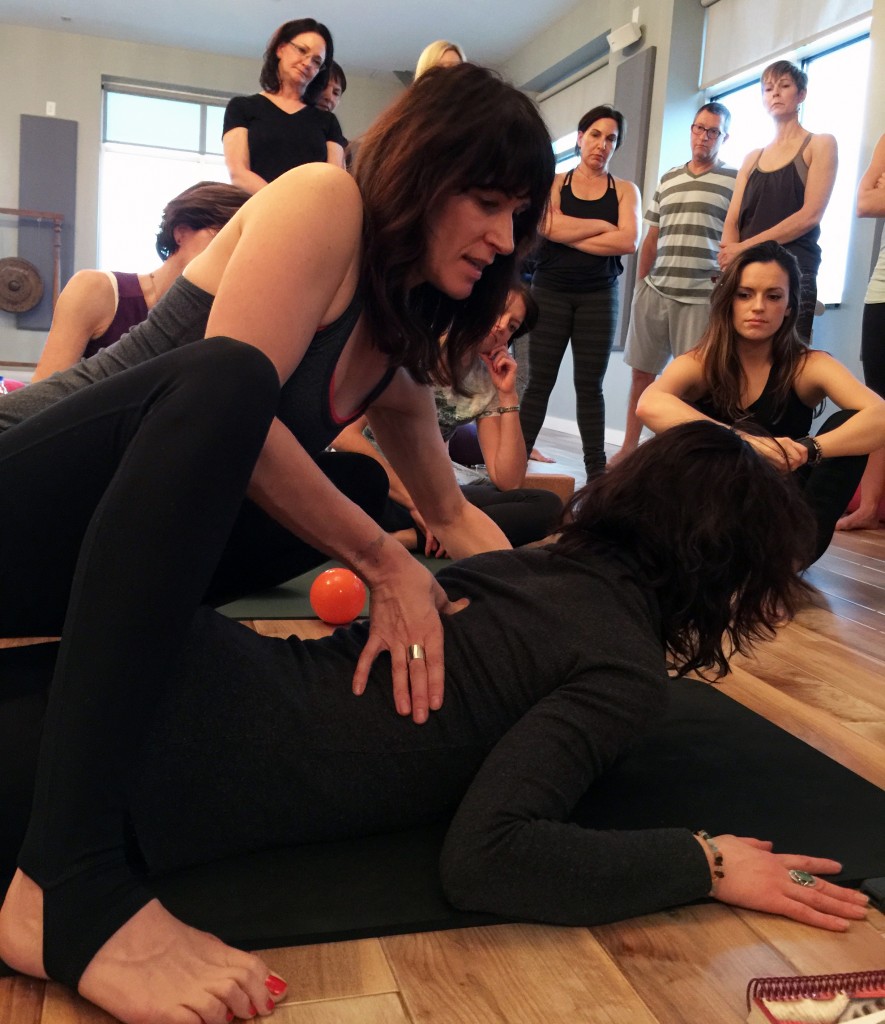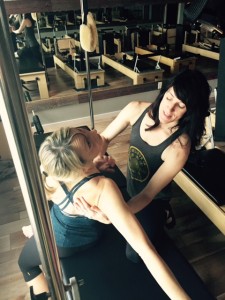January 17, 2018
A Question of Potential
By Chantill Lopez
The scene: Halfway through class, bodies warm and faces flush, you’re ready to take it up a notch, venture into an area that’s sometimes tricky to teach and often difficult for students to “find”.
Swan.
You’ve been practicing Rocking Swan for the past two weeks in a variety of iterations, working out the kinks. You’re feeling confident that your students are going to get it. Maybe, you think, they’re even going to LIKE it. You. Are. Ready.
You: Smiling with cautious optimism, “Okay, today we’re going to explore Swan with some progressions that will move us toward the full expression of the exercise!”
Students: Some frowning with blatant pessimism, “Uhhh. Ahhhh…Swan?!”
“That’s sooo hard.”
“My back doesn’t like that.”
“Can we modify?”
“Not Rocking Swan, right?!”
“I definitely can’t do that one!”
They shift awkwardly on their mats. Some take child’s pose, others sit and fidget staring at you blankly. Waiting.
You: Deflated, you’re not totally sure how to proceed. You don’t want to force them to do it. You don’t want to make them uncomfortable. You want them to like the class. How much do you push them? Quick. Make a decision.
“Don’t worry. Only Swan Prep. That one’s easy. We’ll keep it mellow.”
Students: “Phew!”
An awkward situation averted. A great opportunity lost.
I’m okay with YOU being uncomfortable. (Big smile) In fact, I want you to be uncomfortable. It’s hard you say? Uh huh. Delightful. Is it painful? Okay, change something so it’s not painful, but stick with uncomfortable. Ask yourself, am I going to die? Am I really okay? Yes? True story. You won’t die. Not today rolling around on the floor. Now ask yourself, what’s the risk of being uncomfortable? It’s harder to breathe? It can be. That’s your nervous system catching up, regulating. Breathe in and out of your nose. That helps. Can you stick with uncomfortable for three more breaths? Bet you can. Mmhm. Rest. Feels good, doesn’t it…

It’s natural to want to please our students, to keep them feeling comfortable(ish), both physically and mentally/emotionally. That’s what they want after all, right? They want to feel good. Many of us are uncertain about how far to push our students, how to determine their “edges” or better yet help them find their edges for themselves. We’re hesitant to take them beyond what we think they’re capable of.
The million dollar question: What ARE they capable of and how do YOU know? You’re not the boss of their body, so what makes you the expert in what they might be capable of? I’m the boss of me. You’re the boss of you. Our students are the bosses of themselves. However, in our strange, often upside down “fitness” universe, we think we’re the boss of our students. NOT a true story.
You ARE an expert in Pilates. To your student, you’re the authority of the tools you have. You’re their guide and their resource. At the end of the day, helping to get a person to move is a beautiful gift to the world. So WOOHOO to us!
And we might be able to do a better job with a little shift in perspective and a realignment of our priorities. (We’re getting to Swan. Promise.)
Another question: Do you believe the body has infinite potential and therefore might actually surprise the hell out of you from time to time? Does your body have this hidden potential? Maybe? Yes? What about the body in front of you? (Notice how you are judging yourself and your student. You have more potential than you think, yes, but you wouldn’t say innnnnfinite amounts (Geez, that would be egotistical). Your student? Well, they have a tad bit less than you because they’re injured, have chronic pain, are overweight, a little older, deconditioned, don’t want to run a marathon, only want to get out of pain…. There’s a limit to everyone’s potential, right?)
The rub: The desire to keep our students working within — what we think is — an appropriately controlled, safe container easily becomes the priority for our teaching, one that we have a very hard time seeing beyond.
Coupled with our well-intentioned tendency to expect that the bulk of our students need to be handled with kid gloves — we’re bombarded with statistics that tell us so: 80% of the American population will suffer from some form of undiagnosed low back pain in their lives; low back pain is the single leading cause of disability worldwide[1]; back pain is the second most common reason for visits to the doctor’s office, outnumbered only by upper-respiratory infections[2] — our teaching becomes a hesitant and watered-down version of what it could be.
 I’ll be the first one to raise my hand and shout Guilty! The shift for me has come around like a helpful (and annoying) little orbit over the years. Just when I thought I was doing a great job of balancing the feel good, juicy stuff with just enough “umph!”, I’d be jarred loose by some idea that makes me say Wait a minute! There’s more here than I thought. I’d realize that I actually had all kinds of stereotypes about bodies and movement that were holding my students hostage to a very low ceiling of potential.
I’ll be the first one to raise my hand and shout Guilty! The shift for me has come around like a helpful (and annoying) little orbit over the years. Just when I thought I was doing a great job of balancing the feel good, juicy stuff with just enough “umph!”, I’d be jarred loose by some idea that makes me say Wait a minute! There’s more here than I thought. I’d realize that I actually had all kinds of stereotypes about bodies and movement that were holding my students hostage to a very low ceiling of potential.
Where does that leave us? It leaves us with a chance to rewind that opening scene. How could we do things differently? How could we assume our students have infinite amounts of potential that neither of us may ever fully understand? What would it be like to assume you don’t know what the body is capable of and simultaneously offer opportunities for you and your students to find out what potential exists in the moment?
There’s no movement more susceptible to holding students hostage to limited potential than when we teach extension. Curious? We’ll be exploring how to reframe and shift our perspective on extension in a forthcoming 2-part article called “Fearless Swan – Is It Possible?”
In the meantime, get uncomfortable, reach further, dive a little deeper. You’ll be surprised where it can take you and your students.
[1] Global Burden of Disease 2010 study.
[2] Statistics from the American Chiropractic Association.
 Chantill Lopez – “Be real. Don’t fake it. Be able to say I don’t know. Laugh at myself. Extend compassion to myself and my students. Enter in fully, every time, ready or not.”
Chantill Lopez – “Be real. Don’t fake it. Be able to say I don’t know. Laugh at myself. Extend compassion to myself and my students. Enter in fully, every time, ready or not.”
After more than 20 years of teaching, 17 of which have been spent teaching Pilates, yoga, dance, meditation and other movement modalities to a complex variety of folks, Chantill’s passion is teaching teachers.
She holds Pilates certifications from the PhysicalMind Institute and Body Kinetics with Master Teacher Carol Appel, is a certified Vinyasa yoga teacher, and has extensively studied the work of Philip Beach, Yamuna Body Rolling, Feldenkrais, the Franklin Method, Authentic Movement, and the Halprin Life/Art Process, as well as Vipasana meditation, Buddhist psychology and The Work by Byran Katie. Chantill’s work currently explores brain-based learning and teaching, motivational strategies, and the integration of the whole-person based on such ideas as somatic and humanistic psychology and the polyvagal theory by Stephen Porges.
She is a Pilates Method Alliance Certified Pilates Teacher (CPT), a Balanced Body Pilates faculty member and the founder of the international education company, Skillful Teaching. Chantill is also the creator of the Thinking Pilates Podcast and author of the book “Moving Beyond Technique,” and the co-creator of the Science + Psychology of Teaching Master’s Program.
You can find Chantill teaching throughout the U.S. and offering online coursework and support to teachers around the world. She actively teaches out of several studios in the Northern California & Bay Area including Sonoma and Napa counties, Sacramento and San Francisco.

